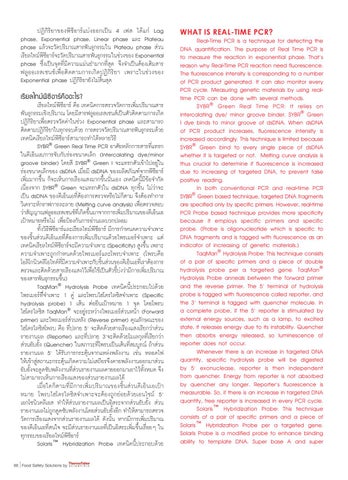ปฏิกิริยาของพีซีอาร์แบ่งออกเป็น 4 เฟส ได้แก่ Lag phase, Exponential phase, Linear phase และ Plateau phase แล้วจะวัดปริมาณสารพันธุกรรมใน Plateau phase ส่วน เรียลไทม์พซี อี าร์จะวัดปริมาณสารพันธุกรรมในช่วงของ Exponential phase ซึ่งเป็นจุดที่มีความแม่นยำ�มากที่สุด จึงจำ�เป็นต้องเติมสาร ฟลูออเรสเซนซ์เพื่อติดตามการเกิดปฏิกิริยา เพราะในช่วงของ Exponential phase ปฏิกิริยายังไม่สิ้นสุด เรียลไทม์พีซีอาร์คืออะไร? เรียลไทม์พีซีอาร์ คือ เทคนิคการตรวจวัดการเพิ่มปริมาณสาร พันธุกรรมเชิงปริมาณ โดยมีสารฟลูออเรสเซนส์เป็นตัวติดตามการเกิด ปฏิกิริยาเพื่อตรวจวัดค่าในช่วง Exponential phase และสามารถ ติดตามปฏิกริ ยิ าในทุกรอบด้วย การตรวจวัดปริมาณสารพันธุกรรมด้วย เทคนิคเรียลไทม์พีซีอาร์สามารถทำ�ได้หลายวิธี SYBR® Green Real Time PCR อาศัยหลักการสารที่แทรก ในดีเอ็นเอ/การจับกับร่องขนาดเล็ก (Intercalating dye/minor groove binder) โดยสี SYBR® Green I จะแทรกตัวเข้าไปอยู่ใน ร่องขนาดเล็กของ dsDNA เมื่อมี dsDNA ของผลิตภัณฑ์จากพีซีอาร์ เพิ่มมากขึ้น ก็จะเห็นการเรืองแสงมากขึ้นนั่นเอง เทคนิคนี้มีข้อจำ�กัด เนื่องจาก SYBR® Green จะแทรกตัวใน dsDNA ทุกชิ้น ไม่ว่าจะ เป็น dsDNA ของดีเอ็นเอที่ต้องการตรวจหรือไม่ก็ตาม จึงต้องทำ�การ วิเคราะห์กราฟการละลาย (Melting curve analysis) เพือ่ ตรวจสอบ ว่าสัญญาณฟลูออเรสเซนซ์ทเี่ กิดขึน้ มาจากการเพิม่ ปริมาณของดีเอ็นเอ เป้าหมายหรือไม่ เพื่อป้องกันการอ่านผลบวกปลอม ทั้งวิธีพซี อี าร์และเรียลไทม์พซี ีอาร์ มีการกำ�หนดความจำ�เพาะ ของชิ้นส่วนดีเอ็นเอที่ต้องการเพิ่มปริมาณด้วยไพรเมอร์จำ�เพาะ แต่ เทคนิคเรียลไทม์พซี อี าร์จะมีความจำ�เพาะ (Specificity) สูงขึน้ เพราะ ความจำ�เพาะถูกกำ�หนดด้วยไพรเมอร์และโพรบจำ�เพาะ (โพรบคือ โอลิโกนิวคลีโอไทด์ทมี่ คี วามจำ�เพาะกับชิน้ ส่วนของดีเอ็นเอทีเ่ ราต้องการ ตรวจและติดด้วยสารเรืองแสงไว้เพือ่ ใช้เป็นตัวชีบ้ ง่ ว่ามีการเพิม่ ปริมาณ ของสารพันธุกรรมขึ้น) TaqMan® Hydrolysis Probe เทคนิคนี้ประกอบไปด้วย ไพรเมอร์ที่จำ�เพาะ 1 คู่ และโพรบไฮโดรไลซิสจำ�เพาะ (Specific hydrolysis probe) 1 เส้น ต่อยีนเป้าหมาย 1 จุด โดยโพรบ ไฮโดรไลซิส TaqMan® จะอยู่ระหว่างไพรเมอร์ส่วนหน้า (Forward primer) และไพรเมอร์ส่วนหลัง (Reverse primer) คุณลักษณะของ ไฮโดรไลซิสโพรบ คือ ที่ปลาย 5’ จะติดด้วยสารเรืองแสงเรียกว่าส่วน รายงานผล (Reporter) และที่ปลาย 3’จะติดด้วยโมเลกุลที่เรียกว่า ส่วนยับยั้ง (Quencher) ในสภาวะที่โพรบเป็นเส้นที่สมบูรณ์ ถ้าส่วน รายงานผล 5’ ได้รับการกระตุ้นจากแหล่งพลังงาน เช่น หลอดไฟ ให้เข้าสู่สถานะกระตุ้นเกิดความไม่เสถียรจึงคายพลังงานออกมาส่วน ยับยัง้ จะดูดซับพลังงานทีส่ ว่ นรายงานผลคายออกมาเอาไว้ทงั้ หมด จึง ไม่สามารถเห็นการเรืองแสงของส่วนรายงานผลได้ เมื่อใดก็ตามที่มีการเพิ่มปริมาณของชิ้นส่วนดีเ อ็นเอเป้า หมาย โพรบไฮโดรไลซิสจำ�เพาะจะต้องถูกย่อยด้วยเอนไซม์ 5’ เอกโซนิวคลีเอส ทำ�ให้ส่วนรายงานผลเป็นอิสระจากส่วนยับยั้ง ส่วน รายงานผลไม่ถูกดูดซับพลังงานโดยส่วนยับยั้งอีก ทำ�ให้สามารถตรวจ วัดการเรืองแสงจากส่วนรายงานผลได้ ดังนั้น หากมีการเพิ่มปริมาณ ของดีเอ็นเอที่สนใจ จะมีส่วนรายงานผลที่เป็นอิสระเพิ่มขึ้นเรื่อยๆ ใน ทุกรอบของเรียลไทม์พีซีอาร์ Solaris™ Hybridization Probe เทคนิคนี้ประกอบด้วย 66 Food Safety Solutions by
WHAT IS REAL-TIME PCR?
Real-Time PCR is a technique for detecting the DNA quantification. The purpose of Real Time PCR is to measure the reaction in exponential phase. That’s reason why Real-Time PCR reaction need fluorescence. The fluorescence intensity is corresponding to a number of PCR product generated. It can also monitor every PCR cycle. Measuring genetic materials by using realtime PCR can be done with several methods. SYBR® Green Real Time PCR: It relies on intercalating dye/ minor groove binder. SYBR® Green I dye binds to minor groove of dsDNA. When dsDNA of PCR product increases, fluorescence intensity is increased accordingly. This technique is limited because SYBR® Green bind to every single piece of dsDNA whether it is targeted or not. Melting curve analysis is thus crucial to determine if fluorescence is increased due to increasing of targeted DNA, to prevent false positive reading. In both conventional PCR and real-time PCR SYBR® Green based technique, targeted DNA fragments are specified only by specific primers. However, real-time PCR Probe based technique provides more specificity because it employs specific primers and specific probe. (Probe is oligonucleotide which is specific to DNA fragments and is tagged with fluorescence as an indicator of increasing of genetic materials.) TaqMan® Hydrolysis Probe: This technique consists of a pair of specific primers and a piece of double hydrolysis probe per a targeted gene. TaqMan® Hydrolysis Probe anneals between the forward primer and the reverse primer. The 5’ terminal of hydrolysis probe is tagged with fluorescence called reporter, and the 3’ terminal is tagged with quencher molecule. In a complete probe, if the 5’ reporter is stimulated by external energy sources, such as a lamp, to excited state, it releases energy due to its instability. Quencher then absorbs energy released, so luminescence of reporter does not occur. Whenever there is an increase in targeted DNA quantity, specific hydrolysis probe will be digested by 5’ exonuclease, reporter is then independent from quencher. Energy from reporter is not absorbed by quencher any longer. Reporter’s fluorescence is measurable. So, if there is an increase in targeted DNA quantity, free reporter is increased in every PCR cycle. Solaris™ Hybridization Probe: This technique consists of a pair of specific primers and a piece of Solaris™ Hybridization Probe per a targeted gene. Solaris Probe is a modified probe to enhance binding ability to template DNA. Super base A and super
